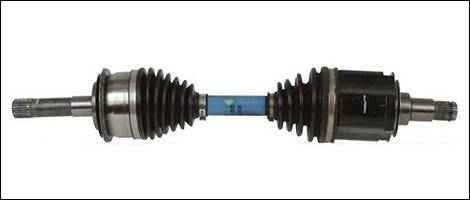Click... Click... Click... The noise becomes louder and scarier, street corner after street corner. There's no denying it anymore : One of the constant velocity (CV) joints is about to fail.
The wonderful thing about constant velocity joints is that, under normal driving conditions, their breaking point is fairly easy to anticipate. While it's not a factory-engineered audible warning like for brake pads, any damage here produces a very characteristic and recurrent sound every time you turn the steering wheel.
CV joints link the wheels to the differential which is connected to the engine. Basically, they're pivots that can transmit rotary motion in any direction. After all, said differential and wheels are never aligned when cornering.
The most common configuration involves dual joints hidden inside rubber covers that are sealed at both ends. These covers aim to protect the joints from sand, rocks, and other road debris that could eat through them. It's filled with grease to further prevent abrasion and corrosion.
CV joints work hard, and like any type of joint, they're sensitive to shocks and grinding. Think about your ankles and how they're easy to sprain. While a big pothole can generate enough of a shockwave to snap the joints, repeated assaults eventually produce the same result.
Trying to extend the life of a clicking constant velocity joint is a gamble you'll most certainly lose. Speaking of losing, you can kiss the wheel goodbye when one of the CV joints fail. You, actually everyone around you, will laugh upon seeing your car resting on three wheels and a battered bumper corner.
DIY folks and amateur grease monkeys should forget about replacing these joints at home. Leave the job to a professional technician at your local dealership. The tricky part is to have the proper tools: There's usually a specific wrench for disconnecting the CV joint from the differential. Also, beware of rust on the various nuts that need to be loosened.
Medium difficulty, medium cost. Calculate an hour of labour or two, and the price of replacement parts for your particular make and model. The difference between you and your favourite mechanic is that he'll probably advise you to replace additional components, so expect to hear about bushings, ball joints, various arms and linkages.
Nothing too complicated, I can assure you. Just stay tuned for my next feature.
The wonderful thing about constant velocity joints is that, under normal driving conditions, their breaking point is fairly easy to anticipate. While it's not a factory-engineered audible warning like for brake pads, any damage here produces a very characteristic and recurrent sound every time you turn the steering wheel.
CV joints link the wheels to the differential which is connected to the engine. Basically, they're pivots that can transmit rotary motion in any direction. After all, said differential and wheels are never aligned when cornering.
 |
| Photo: Napa Auto Parts |
The most common configuration involves dual joints hidden inside rubber covers that are sealed at both ends. These covers aim to protect the joints from sand, rocks, and other road debris that could eat through them. It's filled with grease to further prevent abrasion and corrosion.
CV joints work hard, and like any type of joint, they're sensitive to shocks and grinding. Think about your ankles and how they're easy to sprain. While a big pothole can generate enough of a shockwave to snap the joints, repeated assaults eventually produce the same result.
Trying to extend the life of a clicking constant velocity joint is a gamble you'll most certainly lose. Speaking of losing, you can kiss the wheel goodbye when one of the CV joints fail. You, actually everyone around you, will laugh upon seeing your car resting on three wheels and a battered bumper corner.
DIY folks and amateur grease monkeys should forget about replacing these joints at home. Leave the job to a professional technician at your local dealership. The tricky part is to have the proper tools: There's usually a specific wrench for disconnecting the CV joint from the differential. Also, beware of rust on the various nuts that need to be loosened.
Medium difficulty, medium cost. Calculate an hour of labour or two, and the price of replacement parts for your particular make and model. The difference between you and your favourite mechanic is that he'll probably advise you to replace additional components, so expect to hear about bushings, ball joints, various arms and linkages.
Nothing too complicated, I can assure you. Just stay tuned for my next feature.


